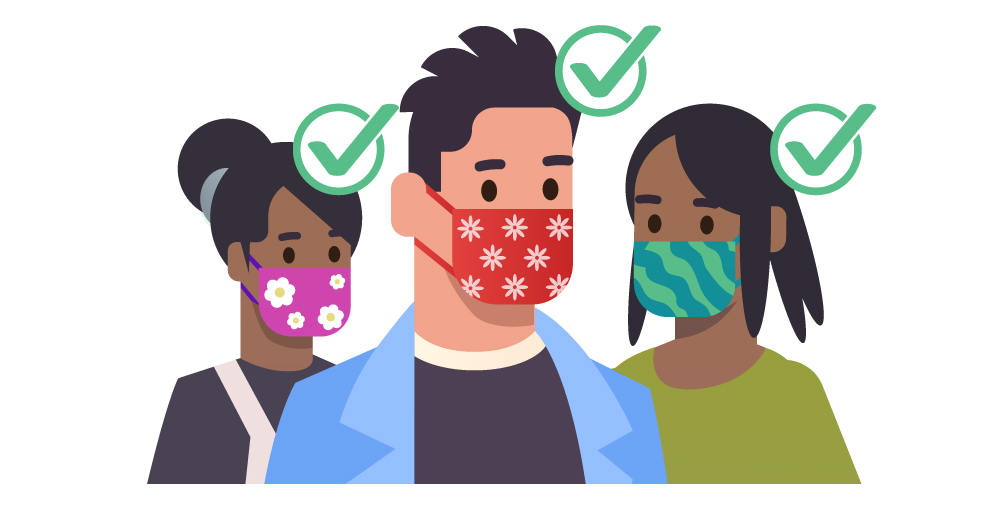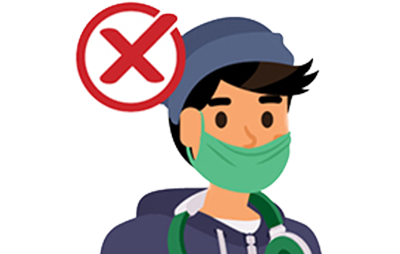Your Guide to Masks
Aug. 6, 2021
According to recent guidance from the United States Centers for Disease Control and Prevention, all individuals ages 2 or older should wear a mask in indoor public spaces – regardless of whether or not you are vaccinated. Currently, individuals ages 12 and up are eligible to be vaccinated in the United States and are encouraged to do so. Information for Alaskans interested in the COVID-19 vaccine can be found here.
In the meantime, here are some helpful tips on how to properly and safely use your mask:
When selecting a mask, there are many choices. Here are some do’s and don’ts.
DO choose masks that:
- Have two or more layers of washable, breathable fabric
- Completely cover your nose and mouth;
- Fit snugly against the sides of your face and don't have gaps.
- Have a nose wire to prevent air from leaking out of the top of the mask
DO NOT choose masks that:
- Are made of fabric that makes it hard to breathe, for example, vinyl
- Have exhalation valves or vents which allow virus particles to escape
- Are prioritized for healthcare workers, including N95 respirators
When choosing masks for your children:
- Find a mask that is made for children to help ensure proper fit
- Check to be sure the mask fits snugly over the nose and mouth and under the chin and that there are no gaps around the sides
- Do NOT put on children younger than 2 years old
People with beards
Certain types of facial hair, like beards, can make mask fitting difficult. Masks that fit well protect you better. To have a better fit, people with beards can shave their beards or trim their beards close to the face.
Other ways to improve fit:
- Use a mask fitter or brace.
- Wear one disposable mask underneath a cloth mask that has multiple layers of fabric. The second mask should push the edges of the inner mask against the face and beard.
For people with beards that are not trimmed close to the face, masks may fit loosely around the beard. However, people with beards should still wear a mask. Masks designed for people with beards are being evaluated, and information will be provided when it becomes available.
Myth busting!
Wearing a mask does not raise the carbon dioxide (CO2) level in the air you breathe.
Cloth masks and surgical masks do not provide an airtight fit across the face. The CO2 escapes into the air through the mask when you breathe out or talk. CO2 molecules are small enough to easily pass through mask material. In contrast, the respiratory droplets that carry the virus that causes COVID-19 are much larger than CO2, so they cannot pass as easily through a properly designed and properly worn mask.
How to Wear
Wear a mask correctly and consistently for the best protection.
Be sure to wash your hands or use hand sanitizer before putting on a mask.
Do NOT touch the mask when wearing it. If you have to often touch/adjust your mask, it doesn’t fit you properly, and you may need to find a different mask or make adjustments.

DO wear a mask that covers your nose and mouth and secure it under your chin and fits snugly against the sides of your face.
How to NOT wear a mask:

- Arond your neck
- On your forehead
- Under your nose
- Only on your nose
- On your chin
- Dangling from one ear
How to take off a mask
- Carefully, untie the strings behind your head or stretch the ear loops
- Handle only by the ear loops or ties
- Fold the outside corners together
- Be careful not to touch your eyes, nose, and mouth when removing and wash hands immediately after removing
How to wash
Reusable masks should be washed whenever it gets dirty or at least daily. If you have a disposable face mask, throw it away after wearing it once. Always and wash your hands after handling or touching a used mask.
Using a washing machine.
- Include your mask with your regular laundry.
- Use regular laundry detergent and the appropriate settings according to the fabric label.
By hand
- Wash your mask with tap water and laundry detergent or soap.
- Rinse thoroughly with clean water to remove detergent or soap.
Dry your mask
Dryer
- Dry your mask completely in a warm or hot dryer
By hand
- Hang your mask in direct sunlight to dry completely. If you cannot hang it in direct sunlight, hang or lay it flat and let it dry completely.
How to Store
Store wet or dirty masks in a plastic bag.
If your mask is wet or dirty from sweat, saliva, make-up, or other liquids or substances, keep it in a sealed plastic bag until you can wash it. Wash wet or dirty masks as soon as possible to prevent them from becoming moldy. Wet masks can be hard to breathe through and are less effective than dry masks.
Store masks that are not wet or dirty in a paper bag
You can store your mask temporarily to reuse later. Remove your mask correctly and wash your hands after touching a used mask. Keep it in a dry, breathable bag (like a paper or mesh fabric bag) to keep it clean between uses. When reusing your mask, keep the same side facing out.
If you are taking off your mask to eat or drink outside of your home, you can place it somewhere safe to keep it clean, such as your pocket, purse, or paper bag. Make sure to wash or sanitize your hands after removing your mask. After eating, put the mask back on with the same side facing out. Be sure to wash or sanitize your hands again after putting your mask back on.
For information on the sources for the CDC's mask guidance, see Recent Studies.
